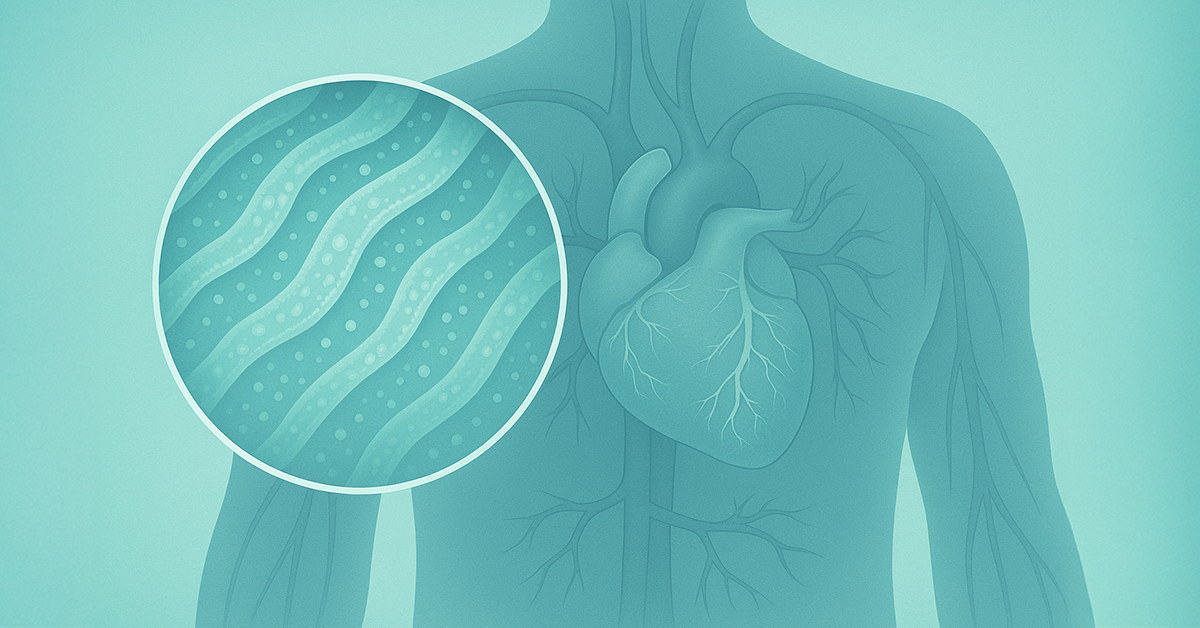
What is Cardiac Amyloidosis?
- | By Ultromics
- Articles, Heart Failure
Contents
Overview I Symptoms I Diagnosis I Management and Treatment I Conclusion
Overview
What is Cardiac Amyloidosis?
Cardiac amyloidosis is a form of restrictive cardiomyopathy that occurs due to the extracellular deposition of insoluble amyloid protein fibrils into myocardium and cardiac vessels [1,2]. The disease is subclassified based on the specific protein involved. While numerous subtypes have been described, many are exceedingly rare. The major subtypes include transthyretin amyloidosis (ATTR cardiac amyloidosis), resulting from misfolding of the transthyretin protein, and a rarer form known as light chain amyloidosis (AL cardiac amyloidosis), caused by the buildup of immunoglobulin light chains [1,2].
Cardiac amyloidosis remains an underdiagnosed disease due to its nonspecific clinical presentation and poor understanding of its true prevalence within the population. However, increasing availability of new therapies and development of non-invasive diagnostics for ATTR cardiac amyloidosis afford new opportunities for clinicians to detect this life-threatening and debilitating disease [3].
AL Amyloidosis
AL amyloidosis is a systemic disease where cardiac involvement is the largest predictor of mortality, and patients with cardiac involvement have an average lifespan of six months from diagnosis. This form is not hereditary and occurs exclusively in individuals aged over 40 years with no difference in frequency between sexes [4]. In AL amyloidosis, the misfolded protein is a monoclonal immunoglobulin light chain produced in the bone marrow [1]. The light chain immunoglobulins are secreted in excess of heavy chain immunoglobulins, with only a small percentage folding into amyloid β-pleated sheets [5]. Damage to the heart is proposed to occur in two ways: (i) infiltration of AL fibrils into the myocardium extracellular space and coronary vessels resulting in cardiomyocyte necrosis and interstitial fibrosis [4], as is the case in other forms of the disease. The second mechanism is unique to AL amyloidosis and is caused by oxidative stress due to the circulation of light chains which are directly myotoxic [4].
ATTR Amyloidosis
In ATTR Amyloidosis, the precursor protein is prealbumin, a thyroxine and retinol transport protein produced in the liver [2]. This can be further subdivided into ATTR wild type (ATTRwt) or hereditary ATTR (ATTRv). ATTRv is inherited as an autosomal dominant trait due to one of more than 130 mutations on chromosome 18 [1,5]. Median survival after diagnosis in untreated patients is poor: 2.5 years for ATTRv caused by the TTR Val122Ile (or pV142I) mutation and 3.6 years for ATTRwt [1].
Wild type ATTR amyloidosis occurs due to the prolonged misfolding and aggregation of the transthyretin protein over time and as such, is increasingly common with age. The heart is the organ most commonly affected, but patients often have a history of carpal tunnel syndrome, biceps tendon rupture, and spinal stenosis.
In hereditary amyloidosis, the misfolded ATTR amyloid fibril infiltrates other organs as well as the heart, including the autonomic and peripheral nervous systems; however, it is cardiac involvement that dictates survival [1]. In ATTRv, it is important to determine the specific mutation causing the amyloidosis, meaning that genetic testing is required to determine treatment as it plays a major factor in disease progression [1].
Signs and Symptoms
According to the American College of Cardiology, clinicians should be aware of clinical manifestations to facilitate rapid diagnosis, which can be broadly grouped into two categories (see figure 2).
Cardiac Features:
- Increased left ventricular wall thickness in the absence of hypertension or valvular heart disease
- Heart failure symptoms
- Diastolic dysfunction
- Atrial fibrillation (AF)
- Conduction system disease
- Elevated cardiac biomarkers
Extracardiac Manifestations:
- History of carpal tunnel syndrome
- Spinal stenosis
- Hip or knee replacement
- Prior shoulder surgery
- Proteinuria, or peripheral/autonomic neuropathy
Diagnosis
Diagnosis of cardiac amyloidosis remains difficult as early signs are often nonspecific. Additionally, patients present with varying symptoms dependent on the aetiology of the disease. It is not currently possible to differentiate between variations based on cardiac symptoms alone as there is considerable overlap [2]. The median time for a diagnosis is two years following symptom onset, considering the median survival time is four months to two years. Therefore, it is critical to find new ways to detect cardiac amyloidosis earlier [7].
How is cardiac amyloidosis diagnosed?
According to the 2023 ACC Expert Consensus Decision Pathway on Comprehensive Multidisciplinary Care for the Patient with Cardiac Amyloidosis: A Report of the American College of Cardiology Solution Set Oversight Committee.
The first stage of diagnosis is establishing clinical suspicion through transthoracic echocardiography and medical history. Upon raising clinical suspicion, diagnosing cardiac amyloidosis begins with a monoclonal protein screen to confirm the presence of plasma disorders, which is suggestive of AL amyloidosis. The result of the protein screening determines which diagnostic pathway the patient undergoes (ATTR vs. AL). It is important to note that the use of scintigraphy in the absence of a protein screen is invalid as there can be overlap in cardiac uptake for ATTR and AL cardiac amyloidosis during imaging. In contrast, the protein screening has a negative predictive value of approximately 99%, and following a negative result, AL amyloidosis can be ruled out. However, if a positive result is returned, a non-invasive diagnostic route is no longer an option, and the patient must undergo biopsy for assessment with Congo Red staining and tissue typing via mass spectrometry to confirm the presence of AL amyloidosis [1].
If AL amyloidosis is ruled out following protein screening, the patient may undergo Tc-PYP scintigraphy. This may be diagnostic of ATTR amyloidosis if a grade 2 or 3 result is returned or heart/contralateral chest ratio >1.5. SPECT is assessed in all positive scans to confirm that uptake represents myocardial retention of the tracer and is not blood pool signal [1].
Following the identification of ATTR cardiac amyloidosis, the TTR gene is sequenced to establish the presence of ATTRwt or ATTRv, which is important for treatment and when considering screening in the patient's family [1].
Management and Treatment
How is Cardiac Amyloidosis treated?
Treatment of AL Cardiac Amyloidosis follows two main objectives. Firstly, to reduce the secretion of free light chains and hence the development of amyloid fibrils. This, in turn, limits the rate at which they deposit in the myocardium and other affected organs. The second objective is managing organ dysfunction through the use of chemotherapy [8]. In addition, clinicians may also consider the use of stem cell therapies [8].
Cardiac amyloidosis focuses on three areas: management of heart failure, management of arrhythmias, and initiation of disease-modifying agents [1].
Stroke volume and LV filling are controlled through bioavailable loop diuretics to manage congestion, and in certain patients, Aldosterone antagonists may be used alone or in conjunction with loop diuretics. Neurohormonal antagonists commonly used in heart failure are often poorly tolerated [1].
For the control of arrhythmias, Amiodarone is the therapy of choice. While pacemakers may be implanted, they should be carefully monitored due to the prevalence of conduction system disease. Implantable cardioverter-defibrillators (ICDs) can be effective in managing ventricular arrhythmias in patients with a reasonable prognosis [1].
Cardiac transplantation may be considered in patients with stage D amyloidosis, accompanied by a chemotherapy-based strategy for AL amyloidosis and after ruling out significant neurologic involvement for ATTR amyloidosis. In ATTR patients where there is neuropathy, a heart and liver transplant may be considered [1]. Chemotherapy options for AL amyloidosis have markedly improved, achieving significant reductions in circulating pathologic light chains. ATTR amyloidosis treatment options include Diflunisal, Tafamidis, and RNA interference approaches, with ongoing research into disease-modifying medications [1].
The key takeaways:
-
Multiple forms of cardiac amyloidosis with varying disease progressions.
-
Clinical symptoms can overlap, meaning it is important to further investigate to ensure the correct diagnosis.
-
Early diagnosis can significantly improve patient outlook and quality of life.
-
Therapies for AL amyloidosis can be highly effective; however, they must be diagnosed early in order to be eligible.
-
Treatment for TTR remains challenging due to cost; however, the outlook is generally better compared to patients with AL amyloidosis.
References:
- Kittelson MM, Maurer MS, Ambardekar AV, et al. Cardiac Amyloidosis: Evolving Diagnosis and Management: A Scientific Statement from the American Heart Association. Circulation, 2020 142(1).
- Kittelson MM, Ruberg FL, Ambardekar AV, et al. 2023 ACC Expert Consensus Decision Pathway on Comprehensive Multidisciplinary Care for the Patient with Cardiac Amyloidosis. Journal of the American College of Cardiology. 2023 81 11:1076–1126.
- Griffin JM, Rosenthal JL, Grodin JL, et al. (2021). ATTR Amyloidosis: Current and Emerging Management Strategies. JACC: CardioOncology, [online] 2021:3(4);488–505.
- Ash S, Shorer E, Ramgobin D, et al. (2021). Cardiac amyloidosis‐A review of current literature for the practicing physician. Clinical Cardiology, 2021:44(3);322–331.
- Griffin JM, Rosenblum H, and Maurer MS. Pathophysiology and Therapeutic Approaches to Cardiac Amyloidosis. Circulation Research, 2021:128(10);1554–1575.
- Nativi-Nicolau JN, Karam C, Khella S, et al. Screening for ATTR amyloidosis in the clinic: overlapping disorders, misdiagnosis, and multiorgan awareness. Heart Fail Rev 2022:27;785–793.
- Wechalekar A, Del Torto A, Quarta C, et al. AL Amyloidosis for Cardiologists. JACC: CardioOncology, 202:4(4);pp.427–441.
- Witteles R. Cardiac Amyloidosis - American College of Cardiology [Internet]. American College of Cardiology. 2016. Available from: https://www.acc.org/latest-in-cardiology/articles/2016/07/07/14/59/cardiac-amyloidosis
- Bianchi G, Zhang Y, and Comenzo RL. AL Amyloidosis: Current Chemotherapy and Immune Therapy Treatment Strategies. JACC: CardioOncology. 2021:3(4);467–487.
Curious about upcoming research and innovation?
Sign up to hear about the latest news.

